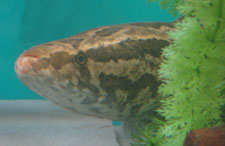Northern Snakehead Fish
(Channa argus)
What are they?

The Northern Snakehead
The northern snakehead is an invasive fish native to China, Russia and Korea. Other snakehead species are native to parts of Asia and Africa. Two populations of this air-breathing predator have been identified in New York State; one in two connected ponds in Queens, NYC and one in Ridgebury Lake in the Town of Wawayanda, Orange County. While the Queens population is confined, the Ridgebury population, situated in the Wallkill River drainage, has the potential to infest the entire Hudson River drainage and beyond to the Great Lakes and continental US. DEC plans to eradicate the Ridgebury population using rotenone.
Why should I care?

Northern Snakehead in a tank
Snakeheads are highly invasive and have the potential to disrupt recreational and commercial fishing, harm native fish and wildlife, and impact our economy. New York State prohibits possession, sale and live transport of snakehead fish (genus Channa and Parachanna) and their viable eggs. Importation and interstate transport of snakeheads is prohibited under federal Lacey Act. Northern snakeheads are top predators capable of growing to at least three feet long and surviving throughout the continental US in a variety of habitats. With teeth similar to our pike and walleye, they are superb predators. They feed voraciously, primarily on other fish but also eat frogs, crayfish and aquatic insects. While they prefer weedy shallow waters, they can inhabit virtually any of our lakes and streams. They tolerate a wider range of oxygen levels than our native species. When oxygen is insufficient to support most of our native fish, snakeheads can breathe air and they may survive for days out of water in damp conditions. Young fish can move across the ground to access water. Snakeheads spawn multiple times each year with females releasing tens of thousands of eggs each time. Eggs hatch in one to two days during the summer and parents guard the young until they begin to feed. Upon hatching, snakeheads feed on zooplankton then begin consuming other fish larvae when they are less than an inch long.
What do they look like?
- Tan to pale brown with dark brown blotches on sides and saddle-like markings on back.
- Elongate body with long dorsal and anal fins.
- Many sharp teeth.
- Large mouth reaching far behind eyes.
- May be confused with bowfin which has a short anal fin, small teeth and often a black spot at base of tail.
What should I do if I see or catch a snakehead?
- REPORT any caught or observed snakehead to DEC's regional fisheries office.
- If you catch one, DO NOT RELEASE it. Kill it immediately, freeze it and report your catch. Take a digital photo if possible
DEC Regional Fisheries Offices
Region 1: 631-444-0280
Region 2: 718-482-4922
Region 3: 845-256-3061
Region 5: 518-897-1333
Region 6: 315-785-2261
Region 7: 607-753-3095
Region 8: 585-226-2466
Region 9: 716-372-0645
More about Northern Snakehead Fish:
- DEC's Plans to Eradicate Northern Snakehead Fish - Information of plans to treat Ridgebury Lake and Catlin Creek to kill off invasive northern snakehead fish
- Northern Snakehead Fish Eradication Plan - Detail information about DEC's plan to kill off northern snakehead fish


